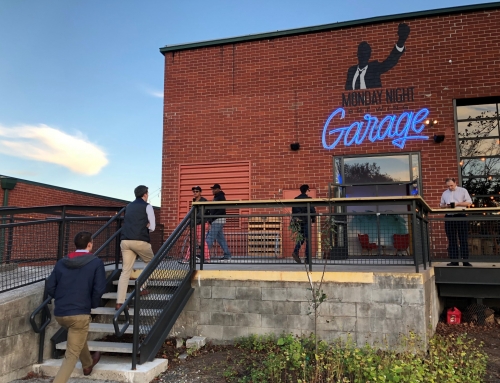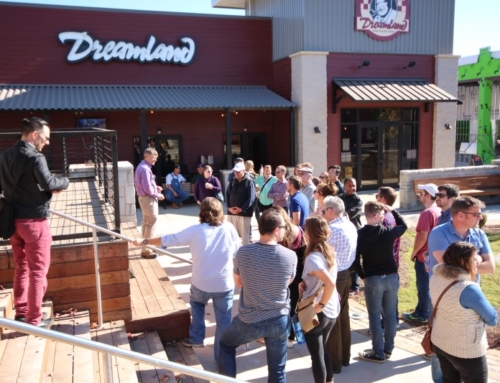The Atlanta Journal Constitutionran a story on a large mixed-use project in downtown Woodstock, Georgia, developed by Hedgewood Properties and designed by TSW.
$75 Million Project to Remake Woodstock’s Downtown
By Chrisophter Quinn
Atlanta Journal-Constitution
06/06/04The wrong side of the tracks in Woodstock is about to become a coveted address.
Thirty-two acres that make up the southeast quadrant of Woodstock’s main intersection grew an outstanding crop of red and white oaks, pines, tangled ivy and songbirds during the last century.
This century, it’s about to sprout an envy-inspiring $75 million crop of new storefronts, offices, townhomes, houses, condominiums and parks.
“I’m sitting right here right now and looking at the woods and can’t imagine $750,000 houses in front of where we live,” said James Hutson, who spent the last 44 years living in one of the few scattered houses on the acreage.
Hutson overstates the top prices for the homes soon to be built — the estimated range is $200,000 to the high $300,000s — but his excitement is understandable. Woodstock has never seen anything like the development.
The large project will remake the former rail stop, which hasn’t changed much since the last passenger train came through in the late 1940s. Downtown Woodstock is but a depot and three blocks of commercial buildings and churches on the west side of Main Street. The mixed-use project will create an east side to the town.
The development, built by Hedgewood Properties, also has sparked the interest of other developers and business owners, who are looking to benefit from the momentum and from the families expected to begin moving in this time next year.
H.C. “Skip” Shipman, owner of Brenda’s House of Flowers on Main Street, recently bought three lots adjoining his business with plans to develop them as the opportunity rises.
“Woodstock has always been a place where you drive through to get to your destination. Hedgewood will allow Woodstock to become the destination,” he said.
“It’s going to really impact the downtown merchants in a very positive way financially. Those willing to work within the parameters of what the city and Hedgewood are trying to accomplish with this project will absolutely make out financially,” he predicted.
Richard McLeod, the city planner, said a couple of other developers have approached him with ideas about new, smaller commercial projects since Hedgewood’s announcement earlier this year.
He and other city leaders want to fend off poorly designed developments that will spoil what they are trying to do — create an easily walkable, pretty new downtown with a consistent design standard. The city is considering a 90-day moratorium on new developments while it puts an overlay or design standard in place.
“We don’t want to kill the goose that laid the golden egg,” McLeod said.
Hedgewood’s plans call for a row of brick townhomes and condominium flats — including 60,000 square feet of space for shops, offices and restaurants — facing across the railroad tracks to the older strip of buildings on Main Street. The new architecture will look traditional. Behind the commercial strip, more townhomes, houses, a 3-acre central park and pocket parks will go up.
“The townhomes will be coming out of the ground in late summer or early fall if things go well,” said David M. Smith, Hedgewood’s development partner for the project.
Transformations
From the restoration of historic Acworth in Cobb County to the creation of a downtown out of nothing in Gwinnett County’s Sugar Hill community, development companies are busy turning burgs or nothing more than a busy crossroads into new, vibrant community centers.
Metro residents tired of subdivisions and drives to strip centers to eat or shop are creating the demand for towns and denser, urban-appearing homes.
The Atlanta Regional Commission’s Livable Centers Initiative grants came at the right time to support the lifestyle change.
The grants, starting in 2000, have doled out millions to help qualifying towns and small cities to develop growth, zoning and transportation plans. Hundreds of millions in follow-up federal grants are promised to help the cities follow through with their dreams by building sidewalks, trails and streetscapes, improving intersections and moving utilities.
Woodstock qualified for a $75,000 grant in 2002 to pay for a city plan.
It changed its zoning last year to allow for the mixed-use type development Hedgewood would propose.
In 2006, the city will receive $125,000 to pay for preliminary engineering. The city is in line to get $1.1 million to put the plan into action.
Hedgewood, which has gained a reputation for building smart suburban developments that harken back to the golden age of neighborhoods and towns, was casting about for a project.
“One of our employees lives in downtown Woodstock and introduced us to the idea
[of locating there],” Smith said. The company was able to put together the largely undeveloped lots along Main Street and Arnold Mill Road.Smith said the LCI plan in Woodstock was critical to Hedgewood locating the project there.
“That gave us a road map to follow,” he said.
Timely news
The news couldn’t have come at a better time for Lara Randall.
After getting laid off from a public relations position, she decided to follow her own development dream and in April opened the Serene Bean, a coffee shop, café and gourmet catering business.
“Most traffic goes through Woodstock. They are not stopping. They are not shopping,” she said. “Woodstock is definitely going to change.”
James Hutson sold 6 acres and his home to Hedgewood and must move by this fall to make way for the new development.
“I’m going to miss [Woodstock], but it’s time for me to go,” he said. But he added quickly, “I want to come back in four years and see what it is.”





